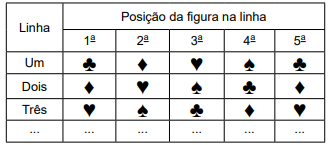Questões Militares
Comentadas para cabo da polícia militar
Foram encontradas 64 questões
Resolva questões gratuitamente!
Junte-se a mais de 4 milhões de concurseiros!
Coal fire crackdown and London mosque stabbing
(Available in: https://www.bbc.com/news/blogs-the-papers-51581385.)
The headline in a British newspaper refers to:
1. It stands for both up-to-date and conventional patterns.
2. People wear it in different ways.
3. Both men and women can wear it.
4. People cannot avoid an arrogant attitude when they put it on.
Mark the affirmative(s) that is/are present in the text.
Considere a distribuição de figuras pelas linhas da tabela:

Mantida a lógica de distribuição, na terceira posição da
linha noventa e dois, constará a figura